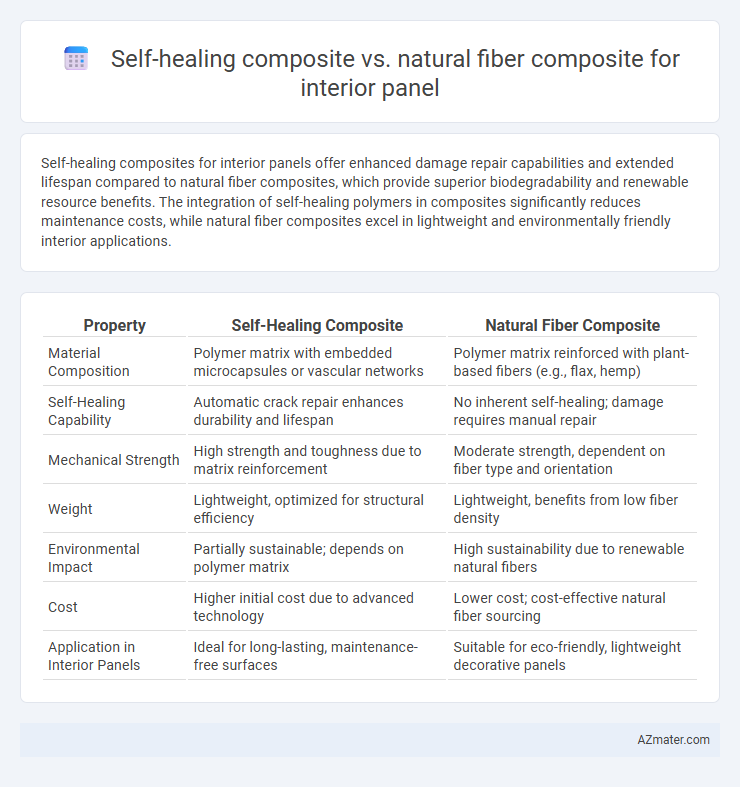Self-healing composites for interior panels offer enhanced damage repair capabilities and extended lifespan compared to natural fiber composites, which provide superior biodegradability and renewable resource benefits. The integration of self-healing polymers in composites significantly reduces maintenance costs, while natural fiber composites excel in lightweight and environmentally friendly interior applications.
Table of Comparison
| Property | Self-Healing Composite | Natural Fiber Composite |
|---|---|---|
| Material Composition | Polymer matrix with embedded microcapsules or vascular networks | Polymer matrix reinforced with plant-based fibers (e.g., flax, hemp) |
| Self-Healing Capability | Automatic crack repair enhances durability and lifespan | No inherent self-healing; damage requires manual repair |
| Mechanical Strength | High strength and toughness due to matrix reinforcement | Moderate strength, dependent on fiber type and orientation |
| Weight | Lightweight, optimized for structural efficiency | Lightweight, benefits from low fiber density |
| Environmental Impact | Partially sustainable; depends on polymer matrix | High sustainability due to renewable natural fibers |
| Cost | Higher initial cost due to advanced technology | Lower cost; cost-effective natural fiber sourcing |
| Application in Interior Panels | Ideal for long-lasting, maintenance-free surfaces | Suitable for eco-friendly, lightweight decorative panels |
Introduction to Interior Panel Materials
Interior panel materials increasingly incorporate advanced composites to enhance durability and performance. Self-healing composites offer innovative damage repair by autonomously restoring structural integrity, reducing maintenance costs and extending lifespan. Natural fiber composites provide lightweight, sustainable alternatives with good mechanical properties and lower environmental impact, making them attractive for eco-friendly interior applications.
Overview of Self-Healing Composites
Self-healing composites for interior panels incorporate microcapsules or vascular networks that release healing agents to autonomously repair cracks, enhancing durability and extending service life. These materials exhibit superior damage tolerance compared to natural fiber composites, which rely on fibers like flax or jute offering biodegradability but limited self-repair capabilities. The integration of self-healing mechanisms improves maintenance efficiency, reduces lifecycle costs, and supports high-performance criteria in automotive and aerospace interior applications.
Understanding Natural Fiber Composites
Natural fiber composites for interior panels leverage renewable fibers like jute, flax, or hemp embedded in polymer matrices, offering enhanced sustainability and biodegradability over synthetic alternatives. These composites provide superior lightweight properties, improved acoustic insulation, and reduced environmental impact, making them ideal for eco-friendly interior applications. Understanding fiber-matrix adhesion and moisture sensitivity is critical to optimizing performance and durability in interior panel use.
Mechanical Properties Comparison
Self-healing composites exhibit superior mechanical properties such as enhanced tensile strength, impact resistance, and fracture toughness compared to natural fiber composites, making them ideal for interior panels requiring durability and longevity. Natural fiber composites offer benefits like lower density, biodegradability, and moderate mechanical strength but generally fall short in self-repair capability and damage tolerance under dynamic loads. The integration of autonomic healing mechanisms in self-healing composites ensures extended service life and reduced maintenance, which is less achievable with conventional natural fiber materials used in interior panel applications.
Durability and Longevity
Self-healing composites for interior panels exhibit superior durability by autonomously repairing micro-cracks, significantly extending the material's lifespan compared to natural fiber composites. Natural fiber composites, while environmentally friendly and lightweight, tend to degrade faster due to moisture absorption and biological attack, reducing long-term performance in interior applications. The enhanced longevity of self-healing composites makes them ideal for high-wear environments where maintenance costs and material replacement are critical concerns.
Sustainability and Environmental Impact
Self-healing composites significantly reduce waste by extending the lifespan of interior panels through inherent damage repair mechanisms, promoting sustainability in automotive and building applications. Natural fiber composites, derived from renewable resources like flax, hemp, or jute, offer low carbon footprints and biodegradability, minimizing environmental impact while ensuring lightweight and durable panel solutions. Combining self-healing capabilities with natural fibers presents innovative pathways for eco-friendly interior panels that optimize resource efficiency and lifecycle performance.
Cost Efficiency and Production Scalability
Self-healing composites offer significant cost efficiency by reducing maintenance and extending the lifespan of interior panels, although their advanced material technology can initially increase production costs compared to natural fiber composites. Natural fiber composites benefit from lower raw material expenses and simpler manufacturing processes, enabling scalable production ideal for mass-market applications. However, self-healing composites present a promising balance between durability and long-term savings, making them a competitive choice for high-performance interior paneling despite current scalability limitations.
Performance in Real-world Conditions
Self-healing composites exhibit superior durability and damage tolerance compared to natural fiber composites, maintaining structural integrity under repeated mechanical stress and environmental exposure. Natural fiber composites often suffer from moisture absorption and biodegradation, leading to reduced performance and shorter lifespan in interior panel applications. The autonomous repair capability of self-healing composites enhances long-term reliability and reduces maintenance costs in real-world interior environments.
Design Flexibility and Aesthetics
Self-healing composites offer enhanced design flexibility for interior panels due to their ability to maintain structural integrity and appearance after damage, enabling innovative, durable designs without compromising aesthetics. Natural fiber composites provide a unique aesthetic appeal with organic textures and color variations, promoting eco-friendly and visually warm interiors. Combining both materials can optimize design freedom and visual impact, meeting diverse functional and stylistic requirements in interior panel applications.
Future Trends in Interior Panel Materials
Self-healing composites for interior panels demonstrate promising advancements with their ability to autonomously repair damages, enhancing durability and lifespan, which aligns with the growing demand for sustainable and low-maintenance materials in automotive and architectural sectors. Natural fiber composites offer eco-friendly benefits, such as biodegradability and reduced carbon footprint, appealing to increasing consumer preference for green materials and regulatory pressures on environmental impact. Future trends emphasize hybrid systems combining self-healing capabilities with natural fibers to achieve optimal performance, sustainability, and cost-effectiveness in interior panel applications.

Infographic: Self-healing composite vs Natural fiber composite for Interior panel
 azmater.com
azmater.com